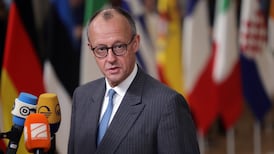The agreement at the Brussels summit last week to approve guidelines for the next phase of negotiations on Brexit marks an important milestone in the complicated and extended talks process.
Discussions between the EU task force on Brexit, under chief negotiator Michel Barnier, and UK negotiators led by Brexit secretary David Davis are now proceeding along several strands towards multiple deadlines, progress in each strand conditional both on progress on the other and on no "backsliding" on what has already been agreed. Ultimately "nothing is agreed until everything is agreed".
On Monday UK and EU negotiators, with input from Irish officials, begin more detailed talks around how exactly both sides can agree to avoid a hard border on the island of Ireland.
Critically, the Withdrawal Agreement, the treaty covering the UK's exit from the EU, has to be ratified by the European Council representing member states, the European Parliament, and the Commons before the UK leaves the union at the end of March next year. To meet that tight deadline the full legal text of the agreement must be completed by October this year, and its broad outlines, EU leaders hope, signed off on by June.
The Withdrawal Agreement will be accompanied by an appendix, a “Political Declaration on the Framework of Future Relations”, work on which was triggered by Friday’s summit decision. It will set out in particular the shape of an ongoing trade relationship, the content of which will only be fleshed out in legal terms for another treaty during the 21-month transition period after Brexit. It is also expected, however, that the declaration will largely be finalised by June, whose summit is now seen as a critical moment.
Divorce settlement
The talks which began last June, widely described as “phase one” or the “divorce settlement”, concerned only the political underpinnings of the Withdrawal Agreement.
The issues to be addressed initially were all about the leaving arrangements. They were broken into three talks strands – citizens’ rights, specifically those of citizens of the EU and UK residing in the other after Brexit; the financial settlement or divorce bill; and Irish issues ranging from the Border to North-South co-operation and the Common Travel Area.
These separate talks led to agreement by both the EU and UK to a single Joint Report in December which allowed leaders to decide at their summit that “sufficient progress” had been made to allow talks to open on transition – the period after the UK leaves the union formally but before it is cut adrift from EU programmes, rules and obligations.
And leaders then authorised the task force to put the Joint Report into legal language as the Withdrawal Agreement – part of that text would be the transition deal.
On the Border the Joint Report contains a commitment to three alternative options for securing a frictionless border: the first, the preferred of all, is based on potential agreement by the UK to such a broad trade agreement between it and the EU that customs posts become unnecessary, in effect the continuation of the status quo on trade but with the UK outside the union.
The second is based on technical means of avoiding checkpoints, from automatic vehicle registration recognition to “trusted trader” schemes and widespread exemptions for small traders.
The third option, known as the "backstop", is a fallback position, or as Simon Coveney refers to it "our insurance policy", should neither of the preferred solutions be agreed. It provides for a commitment by the UK to regulatory alignment on the island of Ireland between North and South on issues underpinning the Belfast Agreement, in effect the vast majority of cross-Border trade-related issues.
Legal commitments
In attempting to translate this agreement into legal commitments, the task force prepared a protocol to its draft Withdrawal Agreement text on the Border. This explicitly provided for Northern Ireland to remain part of the customs union and would have necessitated customs checks between the North and the rest of the UK. A step too far, the UK said, demanding what it saw as a return to the principles enunciated in December in a different elaboration.
The Border issue and unresolved issues over “governance” – specifically the role of the European Court of Justice in upholding the Withdrawal Agreement in the UK post-Brexit – have been left as the two major unresolved issues of the Withdrawal Agreement after broad agreement on citizens’ rights and the formula for calculating the UK Brexit bill. These will now be addressed by negotiators – a continuation of phase-one talks – between now and June, along with a number of issues never dealt with in the Withdrawal Agreement.
These include the fate of so-called “geographic indicators” – the EU wants the UK to continue to give legal protection to specified products like Camembert and cognac; judicial co-operation; intellectual property; and data protection and sharing.
The 120-page legal text of the Withdrawal Agreement published this month, 90 per cent plus of which has been agreed, also contains the text on transition – although the UK still prefers to call it the “implementation period”, the Withdrawal Agreement explicitly refers to “transition”.
Rights and obligations
During the 21 months the UK will continue to enjoy all its current rights and obligations without, however, a seat at the decision-making table. It will be consulted, but not given a veto, on new legislative measures which it will be expected to implement during the period.
The UK will also be allowed to begin to negotiate new trade agreements with third countries, though these may not become operational until the end of transition.
In order to prepare the now imminent phase-two discussions on the future trading relationship the Council of Ministers prepared guidelines for negotiators which were approved at the summit. The talks – phase two – will start shortly.
The guidelines assume UK stated red lines on leaving the customs union and the single market, and suggest an EU willingness to embrace a comprehensive free trade agreement with no tariffs or quotas on goods and discussion of “equivalence” arrangements for regulating financial services.
The task force has included a clause that makes clear, however, that if the UK removes some of its red lines it is also willing to show flexibility.
The negotiators on the framework are charged, as one task force member put it, with coming up, if possible by June, with proposals for a new relationship that are “detailed enough to ensure leaders do not get surprised by elements which emerge subsequently” in the final Future Relationship treaty talks – phase three. In essence they are doing for that treaty text what the teams did in preparing the political agreement represented by the Joint Report.
Technical
In parallel, talks on phase one – the Withdrawal Agreement – will continue with some seven meetings scheduled this month alone on Irish issues. The discussions, that are regarded as “technical”, will include Irish officials as part of the task force team.
The ratification process is not simple. When the finalised Withdrawal Agreement treaty goes to leaders they must support it by what is called a “super-qualified” majority of 20 countries out of 27, representing 65 per cent of the EU’s population. No individual state will at that point have a veto, although earlier decisions at the European Council, leaders meetings, have to be approved by unanimity.
The later treaty on the Future Relationship must, on the other hand, get the approval of all the member states individually – whether by parliamentary vote or referendum – as well as the European Parliament. This is a legal requirement of “mixed” treaties which affect national competences. Some states, like the Belgians, will put the treaty to each of their regional parliaments.
Barnier, who has made a virtue of his engagement at every stage with all the stakeholders in the system from member states to MEPs, has already also begun touring national parliaments to lay the ground for such votes.










